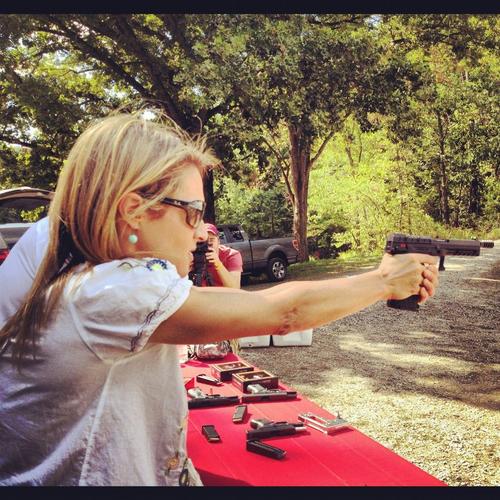“We Got Caught Off Guard”: Winchester President Discusses Ammo Shortage And What’s To Come
Authored by Emily Miller via Emily Post News,
This is part two in a series of interviews with ammunition manufacturing executives. Read my interview with Jason Hornaday here.

More than twice as many Americans have guns and do shooting sports than have golf clubs and putt on a green.
You wouldn’t know that if you are the coastal elite. But the president of Winchester Ammunition, Brett Flaugher, who lives and works in Illinois, says these recreational shooters are driving the historic ammo shortage in America.
“I’ve never taken anyone shooting for the first time who didn’t enjoy it,” Flaugher told me in an interview. “I see it every day out there – the increase in recreational shooting. A lot of people were introduced to shooting sports during the pandemic. It started with wanting to go outside, and now it’s sheer numbers from the positive experience.” Winchester, which is owned by the Olin Corporation, has manufacturing plants in Illinois, Missouri and Mississippi.
Demand for ammunition rose with the pandemic for people who wanted a safe, outdoor activity, but then stayed at record levels. Flaugher said there are a whopping 52 million people in the U.S. who participate in shooting sports. Flaugher said demand for ammo has more than doubled in the past year and a half. In particular, gun club recreational shooting is “off the charts right now.”

For those of you not familiar with ammunition, I learned about it when I visited Winchester in 2012 with other female journalists. This is what in my book, Emily Gets Her Gun (page 67) about the three types of ammo:
Rimfire, the oldest style, has a one-piece casing of metal that goes around the whole shell, encasing the bullet, gunpowder, and primer.
The second style is a shotgun shell—a shell case, which is a complex mix of plastic and metal, plus either a slug or a lot of small pellets.
The third type of ammunition is the modern kind called centerfire. It is the highest-powered and most commonly used for personal defense. The brass or steel casing of the cartridge holds the gunpowder. At the base of the case is the primer that, when struck by the gun’s firing pin, ignites the powder charge. The bullet, the projectile that leaves the gun and hits the target, which is normally made of lead, is surrounded by a jacket of copper or copper plate.
The supply chain
The reason for the ammo shortage is that all the inventory was depleted in the first three months of the pandemic, Flaugher explained. The stock of ammo in the warehouses, wholesalers and retail shelves sold fast. The manufacturers can’t build it back up because people are buying whatever they can find.
“I’m highly disappointed we can’t offer every consumer a good experience in buying ammunition. It’s not fun for us to have a situation where a customer wants to go out and hunt or shoot or buy ammunition for personal protection but can’t. It’s frustrating for us as well,” he said.
“What they need to really understand is that Winchester and every other ammunition manufacturer are doing everything we can to get more to that consumer. Just like they got caught off guard with this level of demand, we got caught off guard too. It just takes a lot of time to be able to get to the level of production based upon the level of demand today. So, hey, we’re frustrated as much as they are. We do not like disappointing our customers.”
Flaugher points to three factors that led to the dramatic increase in those early months that depleted the back stock of ammunition. The first thing that caused the supply chain to dry up was the increased level of concern that people have for their personal security because of the pandemic and civil unrest.
The second factor was the increase in people doing shooting sports, hunting and outdoor activities. The third issue is the public’s heightened concern about new gun-control laws and actions by the Biden administration and a Democratic-controlled Congress that would limit their ability to buy what they want.
The ammo demand matches gun sales. The NSSF adjusted NICS checks show that 21 million firearms were sold in 2020, of which about 9 million were sold to first time gun buyers. “Every time someone buys a gun, what do they buy with it? Ammo,” said Flaugher. “It was all in just a short period of time — that so many new gun owners went into the market.”
Like their competitors, Winchester is trying to do things to increase output. They’ve added equipment to their factories. They have hired and trained hundreds of more people.
Women and guns
I asked Flaugher about the NSSF reports that female gun ownership has increased substantially in the last year.
“We’ve been talking about this at Winchester — we’ve seen women entering gun ownership because of personal defense, that’s nothing new. But it’s continuing and at a higher rate because of the personal security concerns last year, because of pandemic, riots and defunding the police. People think they have to take responsibility for defending themselves and women are doing that as well.”
He said there are two main reasons that people take up shooting sports, training for personal defense and spending recreational time with friends and family. And women just want to be a part of the fun at the ranges.
Questions from readers
After I interviewed Jason Hornady about the ammo shortages, I got a lot of “Emily Posts” subscribers asking me more questions. I replied in the comments that I was interviewing another unnamed ammunition manufacturer executive to get more answers. The questions below are from readers and the answers from Flaugher.
Q: Why can’t Winchester make enough shotgun shells for the market?
Flaugher: “People are outdoors shooting traps, skeet, sporting clays — all that recreational activity is driving a huge amount of demand for us that we just can’t keep up at this point,” Flaugher explained. “Then you have high school shooting teams on top of that for shotgun shells.”
Q: What percentage of ammunition goes to governmental agencies?
Flaugher: “On the conspiracy theories, there is not one theory that I’ve heard that has an ounce of truth to it. Winchester is the primary supplier to the U.S. government’s military. And if anybody would know if the government was buying historically more than they have in previous years, we would know. They’re not.”
Q: Which calibers are in the greatest demand?
Flaugher: “Well they are all in a very very high level demand. But the calibers I would tell you are in the highest demand are 9mm pistol and 5.56 – those two more than any other.”
Q: What about supply and costs of raw materials and components?
Flaugher: “Winchester manufactures all of its own components- the bullet, brass and primer. We get our propellent from a third party.”
“Our key raw materials are lead and brass and resin. We are not being affected by supply of key raw materials, but — there’s a big but there — but supply has been tight, and we continue to manage that, but it has not affected our ability to produce.”
Why are primers out of stock?
Flaugher: “Primers are at high demand for the same reasons that loaded ammunition is at high demand. There are more people buying them. There are more people loading them. There are more people shooting. Participation is up. It’s no different, but with one little element, the fact that we have to use more primers because we are making more ammunition. That’s a minor part of it. Most of it is just because demand is high.”
He added that, “I think they’ll see better supply down the road.”
The future
So how long will it take for consumers to see the shelves stocked again? “I think you’re looking at least through 2022, a year and a half away, based upon the continuation of participation we’re seeing, based upon the level of guns being sold today,” he said.
I asked if he wanted to address the people who are stockpiling, which frustrates my readers who just want to shoot.
“I would encourage people not to overbuy just because they may not get it tomorrow. But it’s gonna be hard for me to convince a consumer not to buy what they want,” he said.
“We are making more than we ever have, faster than we ever have, and we are trying to satisfy their needs as best we can right now.”
It seems that, what started as panic buying during the pandemic, has led to a change in recreational activities for Americans, and this one doesn’t involve ugly golf clothes.
“A lot of people were introduced to shooting sports during the pandemic. There are a lot more new gun owners out there. And I actually think people have enjoyed their experiences shooting , even though the ammunition is hard to get,” said Winchester’s president. “We offer a sport — whether for pure recreation or for personal protection — that is meaningful.”
* * *
Readers- This post is free for for signing up for my newsletter. But I hope you will consider supporting me to continue this work and to get access to all my posts by becoming a paid subscriber. It’s just $6 for a month. No ads and cancel anytime. You can also help me do this work by sharing this post. Thank you!
Tyler Durden
Fri, 06/18/2021 – 23:40![]()
Zero Hedge’s mission is to widen the scope of financial, economic and political information available to the professional investing public, to skeptically examine and, where necessary, attack the flaccid institution that financial journalism has become, to liberate oppressed knowledge, to provide analysis uninhibited by political constraint and to facilitate information’s unending quest for freedom. Visit https://www.zerohedge.com
